

Compact Muon Solenoid
LHC, CERN
| CMS-PAS-SUS-21-003 | ||
| Search for top squarks decaying via the four-body mode in single-lepton final states from Run 2 of the LHC | ||
| CMS Collaboration | ||
| June 2022 | ||
| Abstract: Results are presented from a search for the pair production of the lightest supersymmetric partner of the top quark (˜t1). The search targets the four-body decay of the ˜t1, which is allowed when the mass difference between the top squark and the lightest supersymmetric particle is smaller than the mass of the W boson. This decay mode consists of a bottom quark, two other fermions, and a ˜χ01, often considered to be the lightest supersymmetric particle. The data correspond to an integrated luminosity of 138 fb−1 of proton-proton collisions at a center-of-mass energy of 13 TeV, collected with the CMS detector. The signature of the selected events is defined by a high-momentum jet, significant missing transverse momentum, and a low transverse momentum electron or muon. The selection of the signal is based on a multivariate approach that is adapted to the m(˜t1)−m(˜χ01) mass difference. Leading background processes are determined from data. No significant excess in data is observed above the expectation from standard model processes. The results of this search exclude top squark masses up to 700 GeV, depending on the m(˜t1)−m(˜χ01) mass difference. | ||
|
Links:
CDS record (PDF) ;
CADI line (restricted) ;
These preliminary results are superseded in this paper, JHEP 06 (2023) 060. The superseded preliminary plots can be found here. |
||
| Figures | |
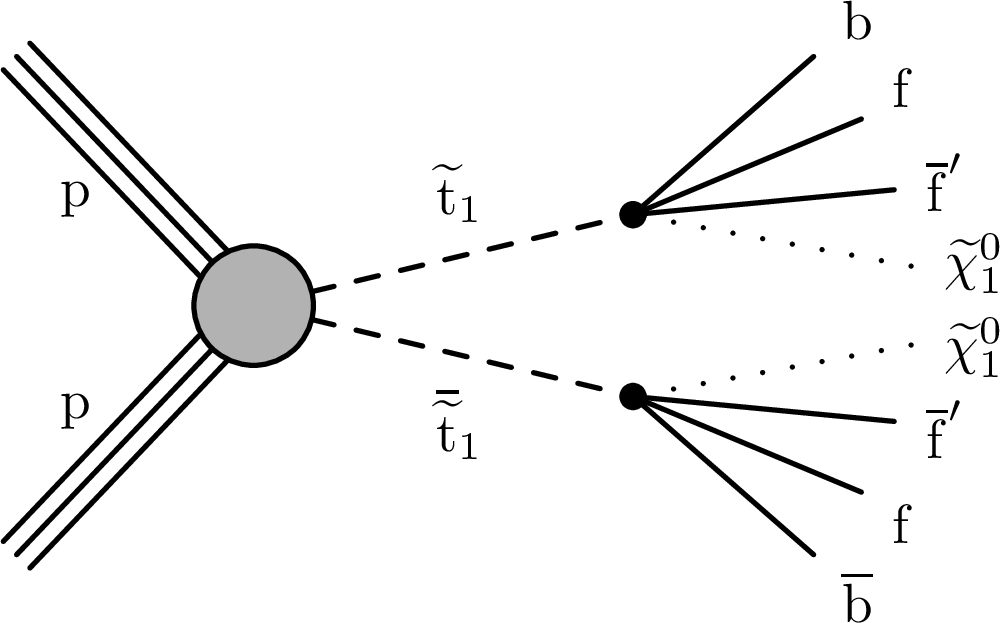
png pdf |
Figure 1:
Top squark pair production at the LHC with four-body decays. |

png pdf |
Figure 2:
Distributions of pT(ℓ) (left), pTmiss (middle), and Njets (right), for the data of 2017 (top) and 2018 (bottom) at the preselection level in data and simulation. The background distributions are obtained directly from simulation, and are normalized to an integrated luminosity of 41.5 fb−1 and 59.8 fb−1 for 2017 and 2018, respectively. The distributions of two signal points are represented, while not being added to the background: (m(˜t1),m(˜χ01))= (500, 490) and (500, 420) GeV. The last bin in each plot includes the overflow events. The lower panels show the ratio of data to the sum of the SM backgrounds, where the dark shaded bands indicate the statistical uncertainties of simulated data. |

png pdf |
Figure 2-a:
Distributions of pT(ℓ) (left), pTmiss (middle), and Njets (right), for the data of 2017 (top) and 2018 (bottom) at the preselection level in data and simulation. The background distributions are obtained directly from simulation, and are normalized to an integrated luminosity of 41.5 fb−1 and 59.8 fb−1 for 2017 and 2018, respectively. The distributions of two signal points are represented, while not being added to the background: (m(˜t1),m(˜χ01))= (500, 490) and (500, 420) GeV. The last bin in each plot includes the overflow events. The lower panels show the ratio of data to the sum of the SM backgrounds, where the dark shaded bands indicate the statistical uncertainties of simulated data. |
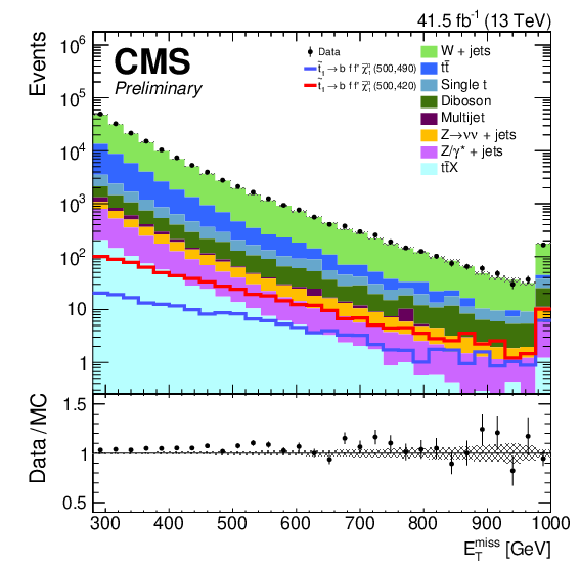
png pdf |
Figure 2-b:
Distributions of pT(ℓ) (left), pTmiss (middle), and Njets (right), for the data of 2017 (top) and 2018 (bottom) at the preselection level in data and simulation. The background distributions are obtained directly from simulation, and are normalized to an integrated luminosity of 41.5 fb−1 and 59.8 fb−1 for 2017 and 2018, respectively. The distributions of two signal points are represented, while not being added to the background: (m(˜t1),m(˜χ01))= (500, 490) and (500, 420) GeV. The last bin in each plot includes the overflow events. The lower panels show the ratio of data to the sum of the SM backgrounds, where the dark shaded bands indicate the statistical uncertainties of simulated data. |
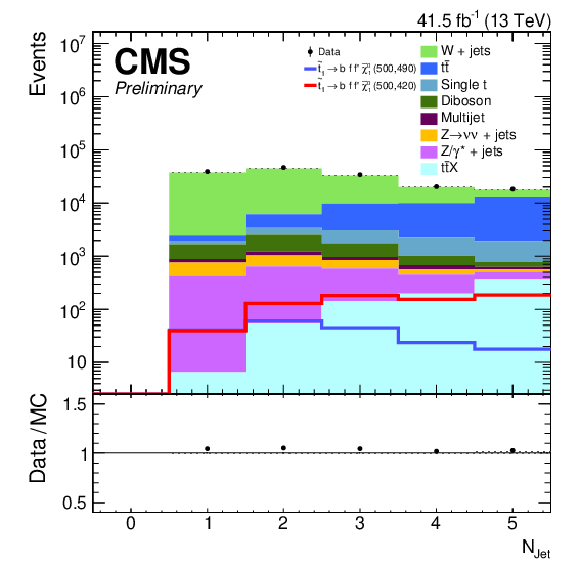
png pdf |
Figure 2-c:
Distributions of pT(ℓ) (left), pTmiss (middle), and Njets (right), for the data of 2017 (top) and 2018 (bottom) at the preselection level in data and simulation. The background distributions are obtained directly from simulation, and are normalized to an integrated luminosity of 41.5 fb−1 and 59.8 fb−1 for 2017 and 2018, respectively. The distributions of two signal points are represented, while not being added to the background: (m(˜t1),m(˜χ01))= (500, 490) and (500, 420) GeV. The last bin in each plot includes the overflow events. The lower panels show the ratio of data to the sum of the SM backgrounds, where the dark shaded bands indicate the statistical uncertainties of simulated data. |

png pdf |
Figure 2-d:
Distributions of pT(ℓ) (left), pTmiss (middle), and Njets (right), for the data of 2017 (top) and 2018 (bottom) at the preselection level in data and simulation. The background distributions are obtained directly from simulation, and are normalized to an integrated luminosity of 41.5 fb−1 and 59.8 fb−1 for 2017 and 2018, respectively. The distributions of two signal points are represented, while not being added to the background: (m(˜t1),m(˜χ01))= (500, 490) and (500, 420) GeV. The last bin in each plot includes the overflow events. The lower panels show the ratio of data to the sum of the SM backgrounds, where the dark shaded bands indicate the statistical uncertainties of simulated data. |
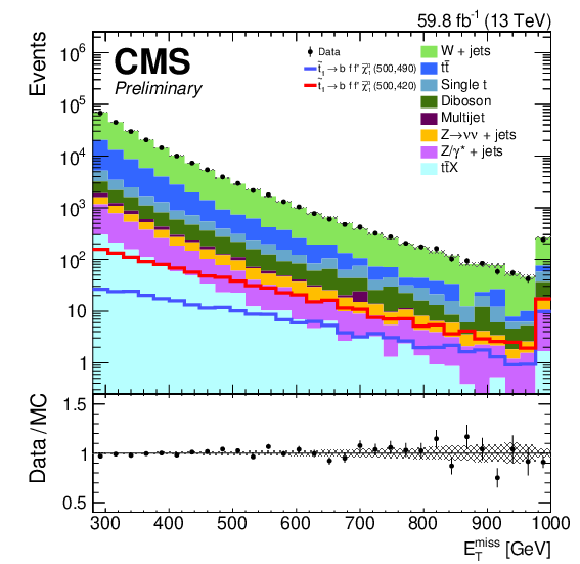
png pdf |
Figure 2-e:
Distributions of pT(ℓ) (left), pTmiss (middle), and Njets (right), for the data of 2017 (top) and 2018 (bottom) at the preselection level in data and simulation. The background distributions are obtained directly from simulation, and are normalized to an integrated luminosity of 41.5 fb−1 and 59.8 fb−1 for 2017 and 2018, respectively. The distributions of two signal points are represented, while not being added to the background: (m(˜t1),m(˜χ01))= (500, 490) and (500, 420) GeV. The last bin in each plot includes the overflow events. The lower panels show the ratio of data to the sum of the SM backgrounds, where the dark shaded bands indicate the statistical uncertainties of simulated data. |
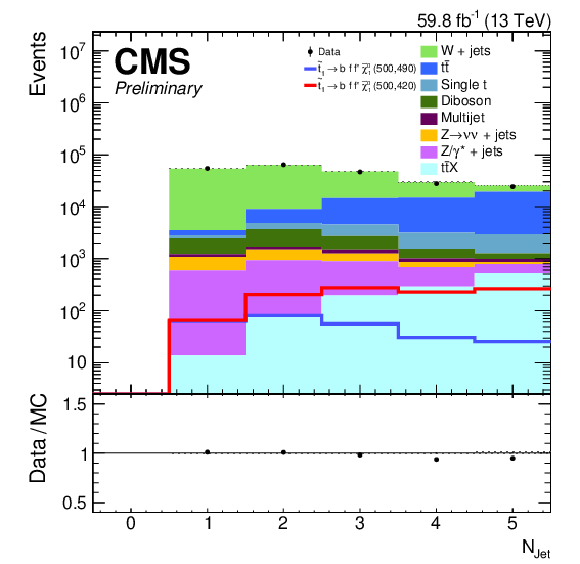
png pdf |
Figure 2-f:
Distributions of pT(ℓ) (left), pTmiss (middle), and Njets (right), for the data of 2017 (top) and 2018 (bottom) at the preselection level in data and simulation. The background distributions are obtained directly from simulation, and are normalized to an integrated luminosity of 41.5 fb−1 and 59.8 fb−1 for 2017 and 2018, respectively. The distributions of two signal points are represented, while not being added to the background: (m(˜t1),m(˜χ01))= (500, 490) and (500, 420) GeV. The last bin in each plot includes the overflow events. The lower panels show the ratio of data to the sum of the SM backgrounds, where the dark shaded bands indicate the statistical uncertainties of simulated data. |
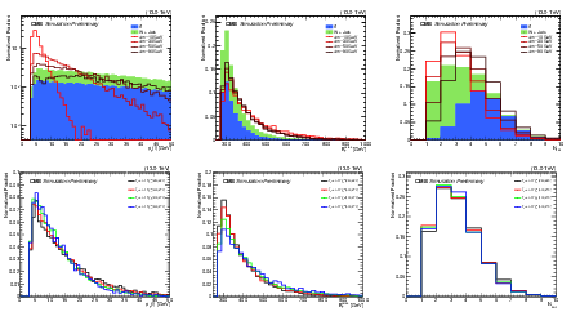
png pdf |
Figure 3:
Simulated distribution of pT(ℓ), pTmiss, and Njets at the preselection level. The area of each signal distribution and the total background are normalized to unit area. Top: Each distribution is shown for signal samples with Δm= 10, 30, 50, and 80 GeV, as well as the W+jets and tˉt background processes. Bottom: Each distribution is shown for various signal points with the same Δm= 30 GeV. |
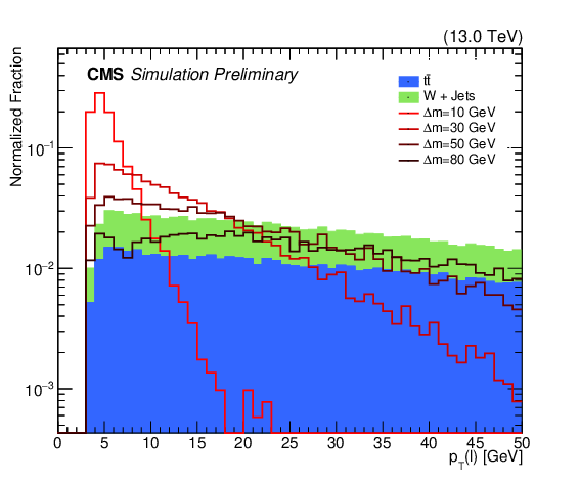
png pdf |
Figure 3-a:
Simulated distribution of pT(ℓ), pTmiss, and Njets at the preselection level. The area of each signal distribution and the total background are normalized to unit area. Top: Each distribution is shown for signal samples with Δm= 10, 30, 50, and 80 GeV, as well as the W+jets and tˉt background processes. Bottom: Each distribution is shown for various signal points with the same Δm= 30 GeV. |

png pdf |
Figure 3-b:
Simulated distribution of pT(ℓ), pTmiss, and Njets at the preselection level. The area of each signal distribution and the total background are normalized to unit area. Top: Each distribution is shown for signal samples with Δm= 10, 30, 50, and 80 GeV, as well as the W+jets and tˉt background processes. Bottom: Each distribution is shown for various signal points with the same Δm= 30 GeV. |

png pdf |
Figure 3-c:
Simulated distribution of pT(ℓ), pTmiss, and Njets at the preselection level. The area of each signal distribution and the total background are normalized to unit area. Top: Each distribution is shown for signal samples with Δm= 10, 30, 50, and 80 GeV, as well as the W+jets and tˉt background processes. Bottom: Each distribution is shown for various signal points with the same Δm= 30 GeV. |
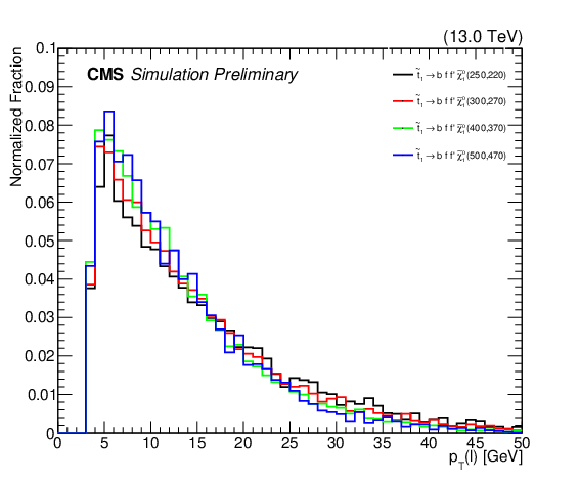
png pdf |
Figure 3-d:
Simulated distribution of pT(ℓ), pTmiss, and Njets at the preselection level. The area of each signal distribution and the total background are normalized to unit area. Top: Each distribution is shown for signal samples with Δm= 10, 30, 50, and 80 GeV, as well as the W+jets and tˉt background processes. Bottom: Each distribution is shown for various signal points with the same Δm= 30 GeV. |
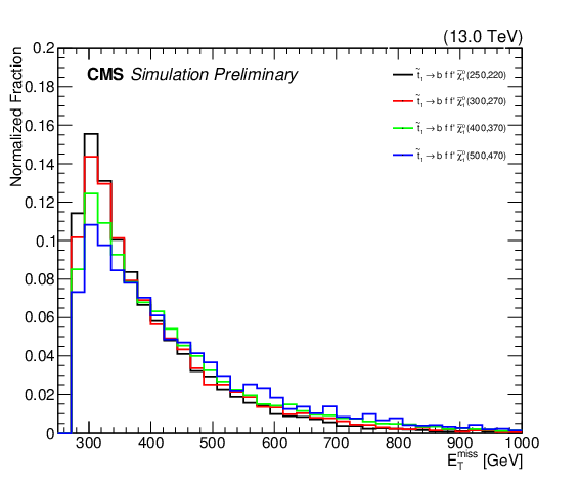
png pdf |
Figure 3-e:
Simulated distribution of pT(ℓ), pTmiss, and Njets at the preselection level. The area of each signal distribution and the total background are normalized to unit area. Top: Each distribution is shown for signal samples with Δm= 10, 30, 50, and 80 GeV, as well as the W+jets and tˉt background processes. Bottom: Each distribution is shown for various signal points with the same Δm= 30 GeV. |
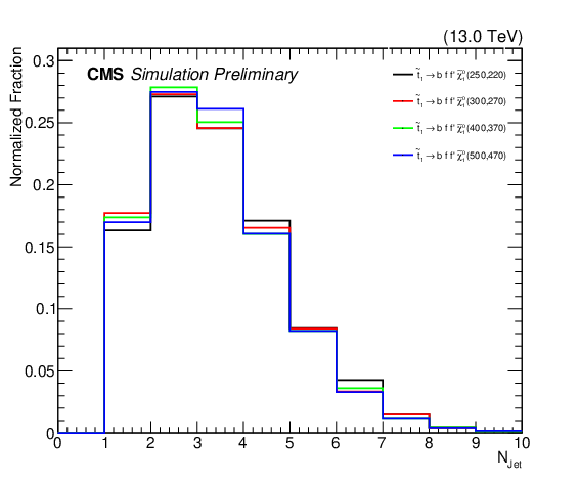
png pdf |
Figure 3-f:
Simulated distribution of pT(ℓ), pTmiss, and Njets at the preselection level. The area of each signal distribution and the total background are normalized to unit area. Top: Each distribution is shown for signal samples with Δm= 10, 30, 50, and 80 GeV, as well as the W+jets and tˉt background processes. Bottom: Each distribution is shown for various signal points with the same Δm= 30 GeV. |
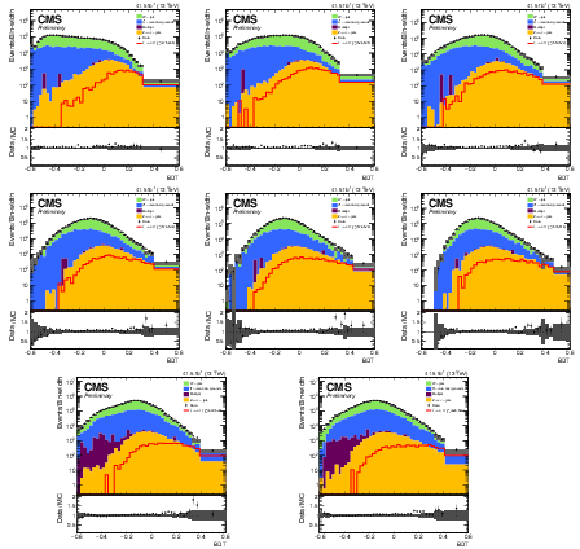
png pdf |
Figure 4:
Distributions of the BDT output at the preselection level in data and simulation in 10 GeV steps of Δm from 10 (top-left) to 80 GeV (bottom-right) for the data of 2017. The last bin represents the SR. For each BDT training, a representative (m(˜t1),m(˜χ01)) signal point is also presented, while not added to the SM background. The shaded area on the Data/MC ratio represents the statistical uncertainty of the simulated background. |
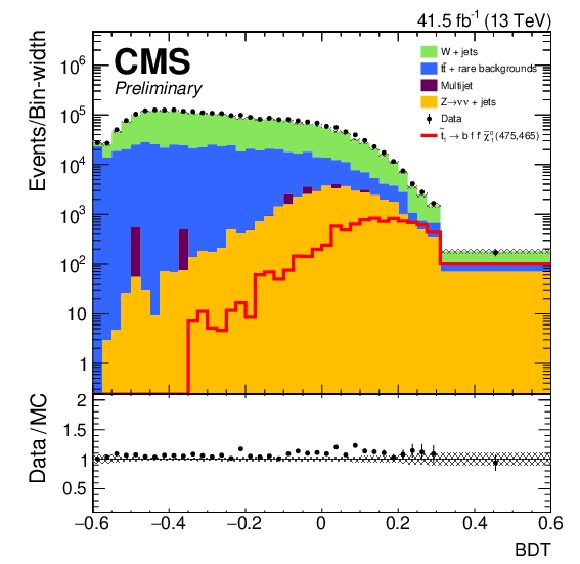
png pdf |
Figure 4-a:
Distributions of the BDT output at the preselection level in data and simulation in 10 GeV steps of Δm from 10 (top-left) to 80 GeV (bottom-right) for the data of 2017. The last bin represents the SR. For each BDT training, a representative (m(˜t1),m(˜χ01)) signal point is also presented, while not added to the SM background. The shaded area on the Data/MC ratio represents the statistical uncertainty of the simulated background. |

png pdf |
Figure 4-b:
Distributions of the BDT output at the preselection level in data and simulation in 10 GeV steps of Δm from 10 (top-left) to 80 GeV (bottom-right) for the data of 2017. The last bin represents the SR. For each BDT training, a representative (m(˜t1),m(˜χ01)) signal point is also presented, while not added to the SM background. The shaded area on the Data/MC ratio represents the statistical uncertainty of the simulated background. |
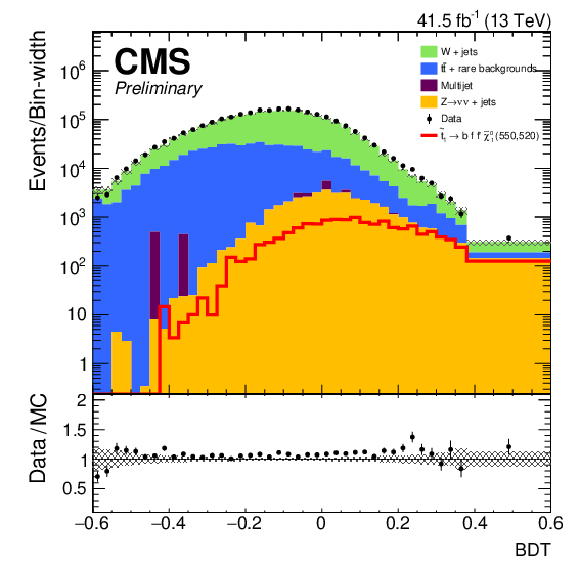
png pdf |
Figure 4-c:
Distributions of the BDT output at the preselection level in data and simulation in 10 GeV steps of Δm from 10 (top-left) to 80 GeV (bottom-right) for the data of 2017. The last bin represents the SR. For each BDT training, a representative (m(˜t1),m(˜χ01)) signal point is also presented, while not added to the SM background. The shaded area on the Data/MC ratio represents the statistical uncertainty of the simulated background. |

png pdf |
Figure 4-d:
Distributions of the BDT output at the preselection level in data and simulation in 10 GeV steps of Δm from 10 (top-left) to 80 GeV (bottom-right) for the data of 2017. The last bin represents the SR. For each BDT training, a representative (m(˜t1),m(˜χ01)) signal point is also presented, while not added to the SM background. The shaded area on the Data/MC ratio represents the statistical uncertainty of the simulated background. |
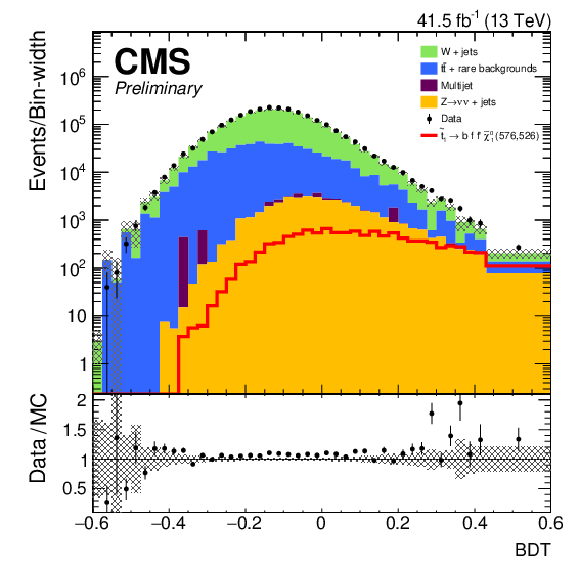
png pdf |
Figure 4-e:
Distributions of the BDT output at the preselection level in data and simulation in 10 GeV steps of Δm from 10 (top-left) to 80 GeV (bottom-right) for the data of 2017. The last bin represents the SR. For each BDT training, a representative (m(˜t1),m(˜χ01)) signal point is also presented, while not added to the SM background. The shaded area on the Data/MC ratio represents the statistical uncertainty of the simulated background. |

png pdf |
Figure 4-f:
Distributions of the BDT output at the preselection level in data and simulation in 10 GeV steps of Δm from 10 (top-left) to 80 GeV (bottom-right) for the data of 2017. The last bin represents the SR. For each BDT training, a representative (m(˜t1),m(˜χ01)) signal point is also presented, while not added to the SM background. The shaded area on the Data/MC ratio represents the statistical uncertainty of the simulated background. |

png pdf |
Figure 4-g:
Distributions of the BDT output at the preselection level in data and simulation in 10 GeV steps of Δm from 10 (top-left) to 80 GeV (bottom-right) for the data of 2017. The last bin represents the SR. For each BDT training, a representative (m(˜t1),m(˜χ01)) signal point is also presented, while not added to the SM background. The shaded area on the Data/MC ratio represents the statistical uncertainty of the simulated background. |
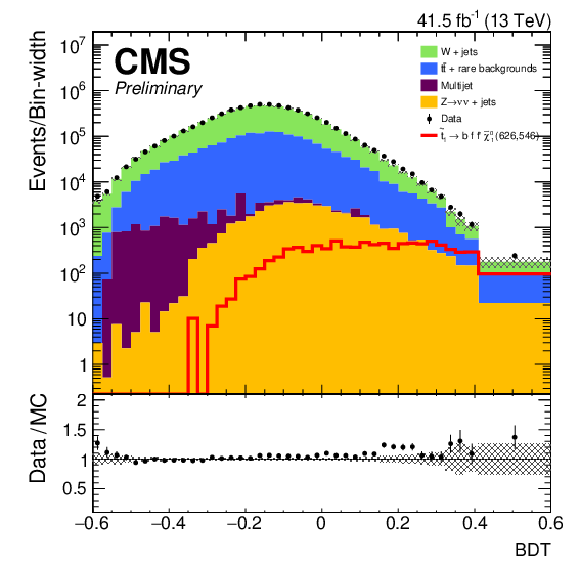
png pdf |
Figure 4-h:
Distributions of the BDT output at the preselection level in data and simulation in 10 GeV steps of Δm from 10 (top-left) to 80 GeV (bottom-right) for the data of 2017. The last bin represents the SR. For each BDT training, a representative (m(˜t1),m(˜χ01)) signal point is also presented, while not added to the SM background. The shaded area on the Data/MC ratio represents the statistical uncertainty of the simulated background. |
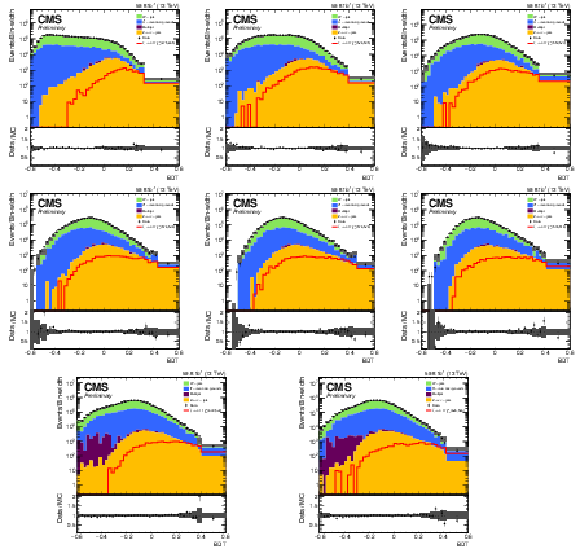
png pdf |
Figure 5:
Distributions of the BDT output at the preselection level in data and simulation in 10 GeV steps of Δm from 10 (top-left) to 80 GeV (bottom-right) for the data of 2018. The last bin represents the SR. For each BDT training, a representative (m(˜t1),m(˜χ01)) signal point is also presented, while not added to the SM background. The shaded area on the Data/MC ratio represents the statistical uncertainty of the simulated background. |
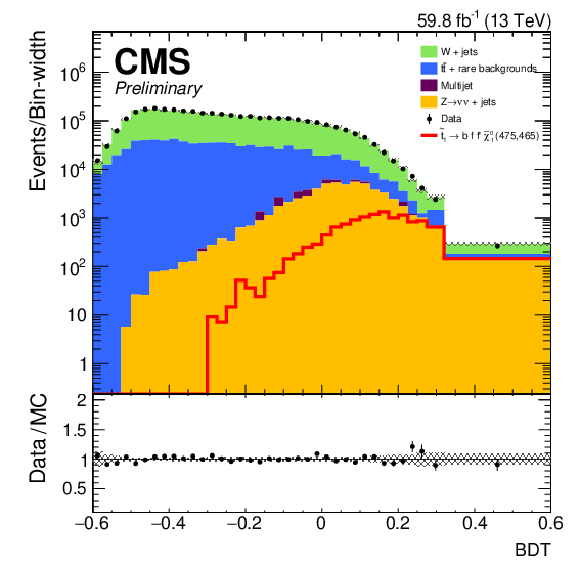
png pdf |
Figure 5-a:
Distributions of the BDT output at the preselection level in data and simulation in 10 GeV steps of Δm from 10 (top-left) to 80 GeV (bottom-right) for the data of 2018. The last bin represents the SR. For each BDT training, a representative (m(˜t1),m(˜χ01)) signal point is also presented, while not added to the SM background. The shaded area on the Data/MC ratio represents the statistical uncertainty of the simulated background. |
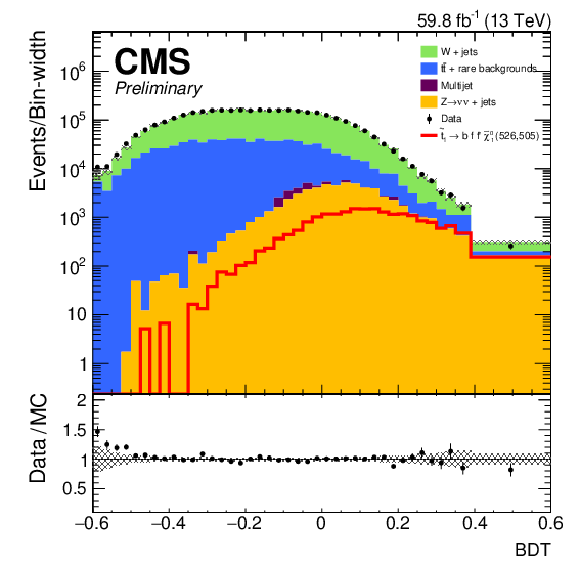
png pdf |
Figure 5-b:
Distributions of the BDT output at the preselection level in data and simulation in 10 GeV steps of Δm from 10 (top-left) to 80 GeV (bottom-right) for the data of 2018. The last bin represents the SR. For each BDT training, a representative (m(˜t1),m(˜χ01)) signal point is also presented, while not added to the SM background. The shaded area on the Data/MC ratio represents the statistical uncertainty of the simulated background. |

png pdf |
Figure 5-c:
Distributions of the BDT output at the preselection level in data and simulation in 10 GeV steps of Δm from 10 (top-left) to 80 GeV (bottom-right) for the data of 2018. The last bin represents the SR. For each BDT training, a representative (m(˜t1),m(˜χ01)) signal point is also presented, while not added to the SM background. The shaded area on the Data/MC ratio represents the statistical uncertainty of the simulated background. |

png pdf |
Figure 5-d:
Distributions of the BDT output at the preselection level in data and simulation in 10 GeV steps of Δm from 10 (top-left) to 80 GeV (bottom-right) for the data of 2018. The last bin represents the SR. For each BDT training, a representative (m(˜t1),m(˜χ01)) signal point is also presented, while not added to the SM background. The shaded area on the Data/MC ratio represents the statistical uncertainty of the simulated background. |
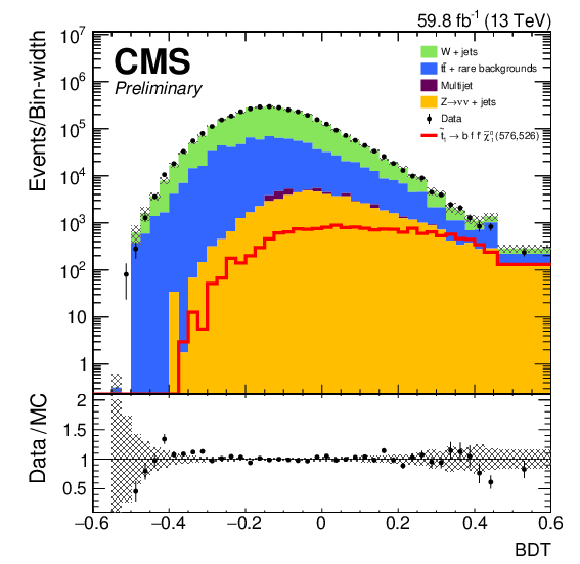
png pdf |
Figure 5-e:
Distributions of the BDT output at the preselection level in data and simulation in 10 GeV steps of Δm from 10 (top-left) to 80 GeV (bottom-right) for the data of 2018. The last bin represents the SR. For each BDT training, a representative (m(˜t1),m(˜χ01)) signal point is also presented, while not added to the SM background. The shaded area on the Data/MC ratio represents the statistical uncertainty of the simulated background. |

png pdf |
Figure 5-f:
Distributions of the BDT output at the preselection level in data and simulation in 10 GeV steps of Δm from 10 (top-left) to 80 GeV (bottom-right) for the data of 2018. The last bin represents the SR. For each BDT training, a representative (m(˜t1),m(˜χ01)) signal point is also presented, while not added to the SM background. The shaded area on the Data/MC ratio represents the statistical uncertainty of the simulated background. |

png pdf |
Figure 5-g:
Distributions of the BDT output at the preselection level in data and simulation in 10 GeV steps of Δm from 10 (top-left) to 80 GeV (bottom-right) for the data of 2018. The last bin represents the SR. For each BDT training, a representative (m(˜t1),m(˜χ01)) signal point is also presented, while not added to the SM background. The shaded area on the Data/MC ratio represents the statistical uncertainty of the simulated background. |

png pdf |
Figure 5-h:
Distributions of the BDT output at the preselection level in data and simulation in 10 GeV steps of Δm from 10 (top-left) to 80 GeV (bottom-right) for the data of 2018. The last bin represents the SR. For each BDT training, a representative (m(˜t1),m(˜χ01)) signal point is also presented, while not added to the SM background. The shaded area on the Data/MC ratio represents the statistical uncertainty of the simulated background. |
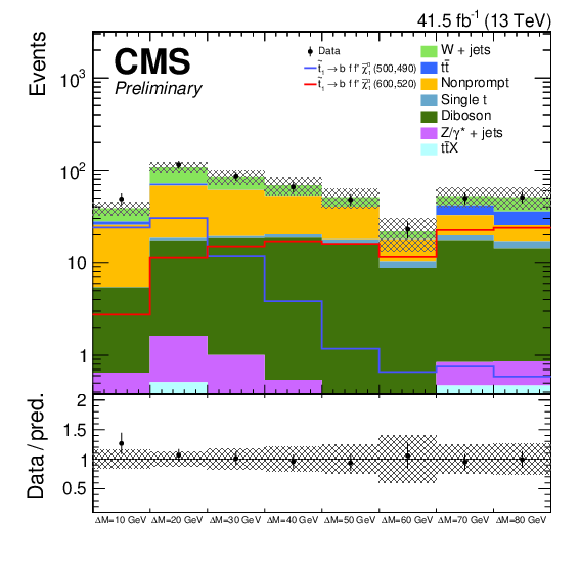
png pdf |
Figure 6:
2017 analysis: Prediction of the total background and its composition in the eight SRs as defined in Table 2. The predictions of W+jets, tˉt, and nonprompt lepton processes are based on data, while that of rare backgrounds is based on simulation. The predictions and their associated uncertainties are pre-fit, as in Table 2. The yield of two signal points, with Δm= 10 and Δm= 80 GeV, is also represented. The bins corresponding to different Δm trainings are not statistically independent. The lower panel shows the ratio of the number of observed events over the predicted total background per SR. |
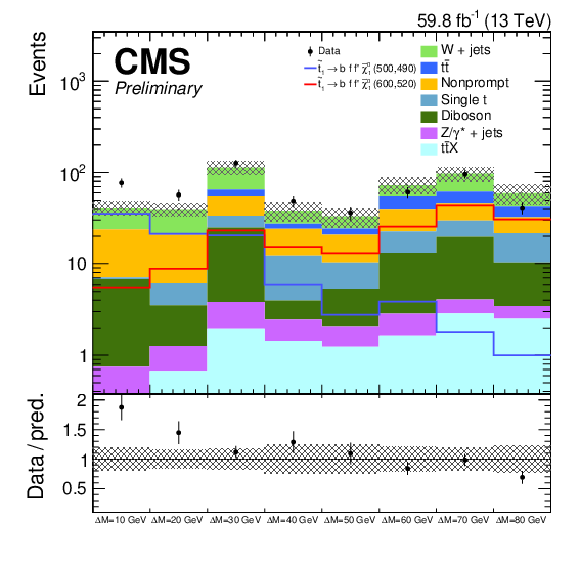
png pdf |
Figure 7:
2018 analysis: Prediction of the total background and its composition in the eight SRs as defined in Table 3. The predictions of W+jets, tˉt, and nonprompt lepton processes are based on data, while that of rare backgrounds is based on simulation. The predictions and their associated uncertainties are pre-fit, as in Table 3. The yield of two signal points, with Δm= 10 and Δm= 80 GeV, is also represented. The bins corresponding to different Δm trainings are not statistically independent. The lower panel shows the ratio of the number of observed events over the predicted total background per SR. |
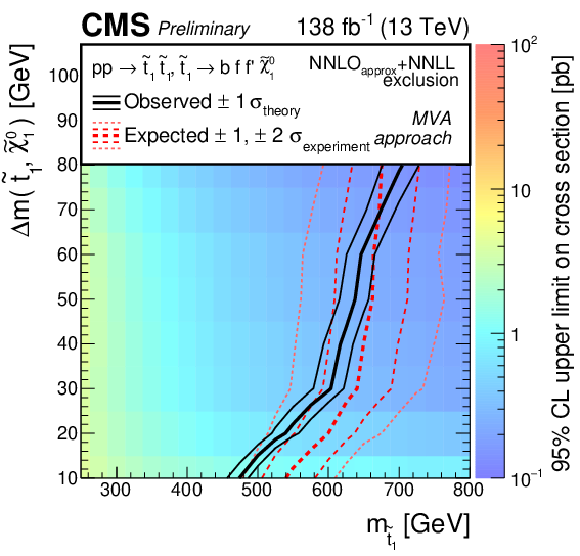
png pdf |
Figure 8:
Exclusion limit at 95% CL for the four-body decay of the top squark as a function of m(˜t1) and Δm for the data of Run 2. The color shading represents the observed limit on the cross section. The solid black and dashed red lines represent the observed and expected limits, respectively. These limits are derived using the expected top squark pair production cross section. The thick lines represent the central values, and the thin lines the variations due to the theoretical or experimental uncertainties. |
| Tables | |
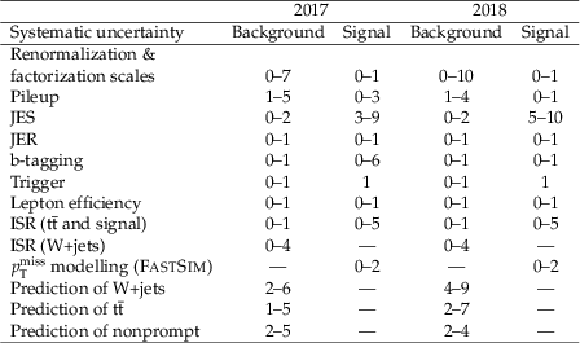
png pdf |
Table 1:
Relative systematic uncertainties (in %) on the total background, and signal prediction for the 2017 (left) and 2018 (right) data analysis. The "---'' means that a given source of uncertainty is not applicable. In the case of the background, the uncertainties are on the total background. The range of each systematic uncertainty is provided across the eight SRs. |

png pdf |
Table 2:
2017 analysis: Prediction of the W+jets, tˉt, nonprompt lepton, and other backgrounds in the eight SRs defined by the threshold on the BDT output reported in the second column. The prediction of the first three processes is data driven, while that of rare backgrounds, NSR(Rare), is based on simulation. The uncertainties are the quadrature sum of the statistical uncertainties, the systematic uncertainties of Table 1, and for the backgrounds predicted from simulation, the cross section uncertainties. The number of total expected background (NSR(B)) and observed data (NSR(D)) events in each SR are also reported. |

png pdf |
Table 3:
2018 analysis: Prediction of the W+jets, tˉt, nonprompt lepton, and other backgrounds in the eight SRs defined by the threshold on the BDT output reported in the second column. The prediction of the first three processes is data driven, while that of rare backgrounds, NSR(Rare), is based on simulation. The uncertainties are the quadrature sum of the statistical uncertainties, the systematic uncertainties of Table 1, and for the backgrounds predicted from simulation, the cross section uncertainties. The number of total expected background (NSR(B)) and observed data (NSR(D)) events in each SR are also reported. |
| Summary |
|
A search for the direct pair production of top squarks is performed in a compressed scenario where the mass difference Δm=m(˜t1)−m(˜χ01) between the lightest top squark and the lightest supersymmetric particle, taken to be the lightest neutralino ˜χ01, does not exceed the W boson mass. The considered decay mode of the top squark is the prompt four-body decay to bf¯f′˜χ01. The result is based on data collected from proton-proton collisions at √s= 13 TeV, recorded with the CMS detector during the Run 2 of the LHC, and corresponds to an integrated luminosity of 138 fb−1. Events are selected where the presence of a single lepton (electron or muon), at least one high-momentum jet, and significant missing transverse momentum are required. The search strategy is based on a multivariate tool that is specifically trained for different Δm regions, thus adapting the selection of th e signal to the evolution of its kinematics through the mmplane plane. The dominant background processes in this search are W+jets, tˉt, and events with nonprompt leptons, and are predicted from control regions in data. After the final selection, data are compatible with the predicted backgrounds stemming from the standard model in all signal regions. Limits are therefore set at 95% confidence level on the production cross section as a function of the ˜t1 and ˜χ01 masses, within the context of simplified models. Assuming 100% branching fraction in the four-body decay mode, and computing the top squark pair production cross section at next-to-next-to-leading order accuracy plus next-to-next-to-leading logarithmic precision [26,27,28,29,30,31,32], these limits are translated into mass limits. The search excludes top squark masses up to 480 and 700 GeV at Δm = 10 and 80 GeV, respectively. The results summarized in this note represent the most stringent limits to date on the top squark pair production cross section, where the top squark decays via the four-body mode. |
| References | ||||
| 1 | S. P. Martin | A supersymmetry primer | Adv. Ser. Direct. High Energy Phys. 18 (1998) 1 | hep-ph/9709356 |
| 2 | J. Wess and B. Zumino | Supergauge transformations in four dimensions | NPB 70 (1974) 39 | |
| 3 | H. P. Nilles | Supersymmetry, supergravity and particle physics | Phys. Reports 110 (1984) 1 | |
| 4 | H. E. Haber and G. L. Kane | The search for supersymmetry: Probing physics beyond the standard model | Phys. Reports 117 (1985) 75 | |
| 5 | R. Barbieri, S. Ferrara, and C. A. Savoy | Gauge models with spontaneously broken local supersymmetry | PLB 119 (1982) 343 | |
| 6 | S. Dawson, E. Eichten, and C. Quigg | Search for supersymmetric particles in hadron-hadron collisions | PRD 31 (1985) 1581 | |
| 7 | ATLAS Collaboration | Observation of a new particle in the search for the standard model Higgs boson with the ATLAS detector at the LHC | PLB 716 (2012) 1 | 1207.7214 |
| 8 | CMS Collaboration | Observation of a new boson at a mass of 125 GeV with the CMS experiment at the LHC | PLB 716 (2012) 30 | CMS-HIG-12-028 1207.7235 |
| 9 | CMS Collaboration | Observation of a new boson with mass near 125 GeV in pp collisions at √s= 7 and 8 TeV | JHEP 06 (2013) 081 | CMS-HIG-12-036 1303.4571 |
| 10 | G. R. Farrar and P. Fayet | Phenomenology of the production, decay, and detection of new hadronic states associated with supersymmetry | PLB 76 (1978) 575 | |
| 11 | C. Bal\'azs, M. Carena, and C. E. M. Wagner | Dark matter, light stops and electroweak baryogenesis | PRD 70 (2004) 015007 | hep-ph/0403224 |
| 12 | A. Delgado et al. | The light stop window | EPJC 73 (2013), no. 3 | 1212.6847 |
| 13 | T. Cohen et al. | Susy simplified models at 14, 33, and 100 TeV proton colliders | JHEP 04 (2014) 117 | 1311.6480 |
| 14 | CMS Collaboration | Search for top squarks decaying via four-body or chargino-mediated modes in single-lepton final states in proton-proton collisions at √s= 13 TeV | JHEP 09 (2018) 065 | CMS-SUS-17-005 1805.05784 |
| 15 | ATLAS Collaboration | Search for new phenomena with top quark pairs in final states with one lepton, jets, and missing transverse momentum in pp collisions at √s= 13 TeV with the atlas detector | JHEP 04 (2021) 174 | 2012.03799 |
| 16 | CMS Collaboration | The CMS trigger system | JINST 12 (2017) P01020 | CMS-TRG-12-001 1609.02366 |
| 17 | CMS Collaboration | The CMS experiment at the CERN LHC | JINST 3 (2008) S08004 | CMS-00-001 |
| 18 | J. Alwall et al. | The automated computation of tree-level and next-to-leading order differential cross sections, and their matching to parton shower simulations | JHEP 07 (2014) 079 | 1405.0301 |
| 19 | S. Alioli, P. Nason, C. Oleari, and E. Re | NLO single-top production matched with shower in POWHEG: s- and t-channel contributions | JHEP 09 (2009) 111 | 0907.4076 |
| 20 | E. Re | Single-top Wt-channel production matched with parton showers using the POWHEG method | EPJC 71 (2011) 1547 | 1009.2450 |
| 21 | NNPDF Collaboration | Parton distributions for the LHC Run II | JHEP 04 (2015) 040 | 1410.8849 |
| 22 | T. Sjostrand, S. Mrenna, and P. Z. Skands | PYTHIA 6.4 physics and manual | JHEP 05 (2006) 026 | hep-ph/0603175 |
| 23 | T. Sjostrand, S. Mrenna, and P. Z. Skands | A brief introduction to PYTHIA 8.1 | CPC 178 (2008) 852 | 0710.3820 |
| 24 | CMS Collaboration | Event generator tunes obtained from underlying event and multiparton scattering measurements | EPJC 76 (2016) 155 | CMS-GEN-14-001 1512.00815 |
| 25 | GEANT4 Collaboration | GEANT4--a simulation toolkit | NIMA 506 (2003) 250 | |
| 26 | W. Beenakker, R. Hopker, and M. Spira | PROSPINO: A program for the production of supersymmetric particles in next-to-leading order QCD | 1996 | hep-ph/9611232 |
| 27 | C. Borschensky et al. | Squark and gluino production cross sections in pp collisions at √s= 13, 14, 33 and 100 TeV | EPJC 74 (2014) 3174 | 1407.5066 |
| 28 | W. Beenakker, R. Hopker, M. Spira, and P. M. Zerwas | Squark and gluino production at hadron colliders | NPB 492 (1997) 51 | hep-ph/9610490 |
| 29 | A. Kulesza and L. Motyka | Threshold resummation for squark-antisquark and gluino-pair production at the LHC | PRL 102 (2009) 111802 | hep-ph/0807.2405 |
| 30 | A. Kulesza and L. Motyka | Soft gluon resummation for the production of gluino-gluino and squark-antisquark pairs at the LHC | PRD 80 (2009) 095004 | hep-ph/0905.4749 |
| 31 | W. Beenakker et al. | Soft-gluon resummation for squark and gluino hadroproduction | JHEP 12 (2009) 41 | hep-ph/0909.4418 |
| 32 | W. Beenakker et al. | Squark and gluino production | Int. J. Mod. Phys. A 26 (2011) 2637 | hep-ph/1105.1110 |
| 33 | CMS Collaboration | The fast simulation of the CMS detector at LHC | J. Phys. Conf. Ser. 331 (2011) 032049 | |
| 34 | CMS Collaboration | Particle-flow reconstruction and global event description with the CMS detector | JINST 12 (2017) P10003 | CMS-PRF-14-001 1706.04965 |
| 35 | M. Cacciari, G. P. Salam, and G. Soyez | The anti-kT jet clustering algorithm | JHEP 04 (2008) 063 | 0802.1189 |
| 36 | M. Cacciari, G. P. Salam, and G. Soyez | FastJet user manual | EPJC 72 (2012) 1896 | 1111.6097 |
| 37 | CMS Collaboration | Performance of electron reconstruction and selection with the CMS detector in proton-proton collisions at √s= 8 TeV | JINST 10 (2015) P06005 | CMS-EGM-13-001 1502.02701 |
| 38 | CMS Collaboration | Performance of CMS muon reconstruction in pp collision events at √s= 7 TeV | JINST 7 (2012) P10002 | CMS-MUO-10-004 1206.4071 |
| 39 | CMS Collaboration | Jet energy scale and resolution in the CMS experiment in pp collisions at 8 TeV | JINST 12 (2017) P02014 | CMS-JME-13-004 1607.03663 |
| 40 | CMS Collaboration | Identification of heavy-flavour jets with the CMS detector in pp collisions at 13 TeV | JINST 13 (2018) P05011 | CMS-BTV-16-002 1712.07158 |
| 41 | L. Rokach and O. Maimon | Data mining with decision trees: theory and applications | World Scientific Pub Co Inc., 2008 ISBN 978-981-277-171-1 | |
| 42 | A. Hoecker et al. | TMVA: Toolkit for multivariate data analysis | PoS ACAT (2007) 040 | physics/0703039 |
| 43 | G. Cowan, K. Cranmer, E. Gross, and O. Vitells | Asymptotic formulae for likelihood-based tests of new physics | EPJC 71 (2011) 1554 | 1007.1727 |
| 44 | CMS Collaboration | Search for new physics in same-sign dilepton events in proton-proton collisions at √s= 13 TeV | EPJC 76 (2016) 439 | CMS-SUS-15-008 1605.03171 |
| 45 | CMS Collaboration | Precision luminosity measurement in proton-proton collisions at √s= 13 TeV in 2015 and 2016 at CMS | EPJC 81 (Apr, 2021) 800. 42 p | CMS-LUM-17-003 2104.01927 |
| 46 | CMS Collaboration | CMS luminosity measurement for the 2017 data-taking period at √s= 13 TeV | CMS-PAS-LUM-17-004 | CMS-PAS-LUM-17-004 |
| 47 | CMS Collaboration | CMS luminosity measurement for the 2018 data-taking period at √s= 13 TeV | CMS-PAS-LUM-18-002 | CMS-PAS-LUM-18-002 |
| 48 | CMS Collaboration | Measurement of the inelastic proton-proton cross section at √s= 13 TeV | 2018. Submitted to JHEP | CMS-FSQ-15-005 1802.02613 |
| 49 | A. Kalogeropoulos and J. Alwall | The SysCalc code: A tool to derive theoretical systematic uncertainties | 2018 | hep-ph/1801.08401 |
| 50 | T. Junk | Confidence level computation for combining searches with small statistics | NIMA 434 (1999) 435 | hep-ex/9902006 |
| 51 | A. L. Read | Presentation of search results: the CLs technique | JPG 28 (2002) 2693 | |
| 52 | ATLAS and CMS Collaborations, LHC Higgs Combination Group | Procedure for the LHC Higgs boson search combination in summer 2011 | ATL-PHYS-PUB/2011-11, CMS NOTE 2011/005, CERN | |

|
Compact Muon Solenoid LHC, CERN |

|

|

|

|

|

|